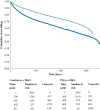Home-based monitoring of falls using wearable sensors in Parkinson's disease
- PMID: 31449705
- PMCID: PMC7003816
- DOI: 10.1002/mds.27830
Home-based monitoring of falls using wearable sensors in Parkinson's disease
Abstract
Introduction: Falling is among the most serious clinical problems in Parkinson's disease (PD). We used body-worn sensors (falls detector worn as a necklace) to quantify the hazard ratio of falls in PD patients in real life.
Methods: We matched all 2063 elderly individuals with self-reported PD to 2063 elderly individuals without PD based on age, gender, comorbidity, and living conditions. We analyzed fall events collected at home via a wearable sensor. Fall events were collected either automatically using the wearable falls detector or were registered by a button push on the same device. We extracted fall events from a 2.5-year window, with an average follow-up of 1.1 years. All falls included were confirmed immediately by a subsequent telephone call. The outcomes evaluated were (1) incidence rate of any fall, (2) incidence rate of a new fall after enrollment (ie, hazard ratio), and (3) 1-year cumulative incidence of falling.
Results: The incidence rate of any fall was higher among self-reported PD patients than controls (2.1 vs. 0.7 falls/person, respectively; P < .0001). The incidence rate of a new fall after enrollment (ie, hazard ratio) was 1.8 times higher for self-reported PD patients than controls (95% confidence interval, 1.6-2.0).
Conclusion: Having PD nearly doubles the incidence of falling in real life. These findings highlight PD as a prime "falling disease." The results also point to the feasibility of using body-worn sensors to monitor falls in daily life. © 2019 The Authors. Movement Disorders published by Wiley Periodicals, Inc. on behalf of International Parkinson and Movement Disorder Society.
Keywords: Parkinson's disease; falls incidence; home-based monitoring; wearable sensor.
© 2019 The Authors. Movement Disorders published by Wiley Periodicals, Inc. on behalf of International Parkinson and Movement Disorder Society.
Figures
References
-
- Peel NM. Epidemiology of falls in older age. Can J Aging 2011;30:7–19. - PubMed
-
- Bloem BR, Grimbergen YA, Cramer M, et al. Prospective assessment of falls in Parkinson's disease. J Neurol 2001;248(11):950–958. - PubMed
-
- Bloem BR, Hausdorff JM, Visser JE, et al. Falls and freezing of gait in Parkinson's disease: a review of two interconnected, episodic phenomena. Mov Disord 2004;19(8):871–884. - PubMed
-
- Fletcher PC, Hirdes JP. Risk factors for falling among community‐based seniors using home care services. J Gerontol A Biol Sci Med Sci 2002;57(8):M504–M510. - PubMed
Publication types
MeSH terms
LinkOut - more resources
Full Text Sources
Medical
Miscellaneous


